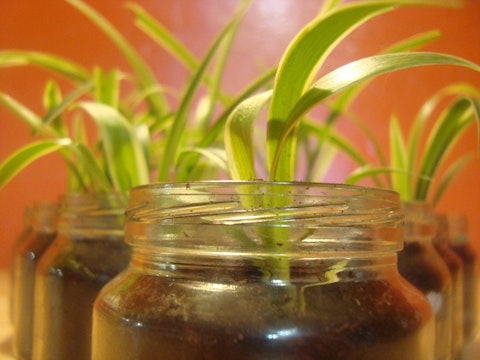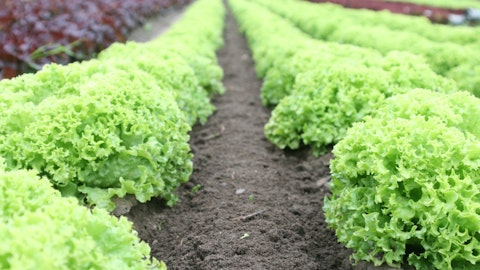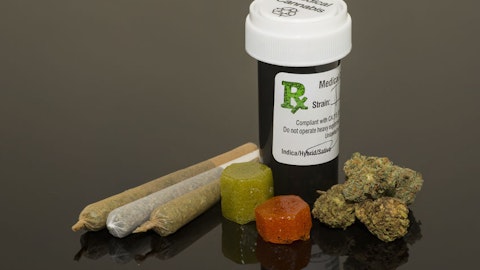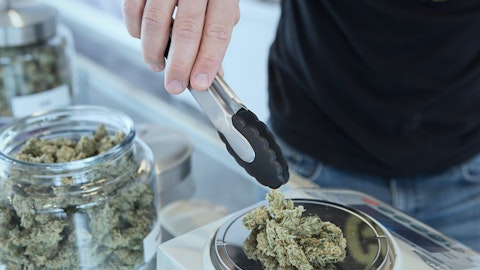Hydrofarm Holdings Group, Inc. (NASDAQ:HYFM) Q4 2022 Earnings Call Transcript March 9, 2023
Operator: Good day, ladies and gentlemen, and thank you for standing by. Welcome to the Hydrofarm Holdings Group’s Fourth Quarter and Fiscal Year 2022 Earnings Conference Call. At this time, all participants have been placed in a listen only mode and the lines will be open for your questions following the presentation. Please note that this conference is being recorded today, March 9, 2023. I would now like to turn the conference call over to Anna Kate Heller at ICR to begin. Please go ahead.
Anna Kate Heller: Thank you, and good afternoon. With me on the call today is Bill Toler, Hydrofarm’s Chairman and Chief Executive Officer; and John Lindeman, the company’s Chief Financial Officer. By now, everyone should have access to our fourth quarter 2022 earnings release and Form 8-K issued today after market close. These documents are available on the Investors section of Hydrofarm’s Web site at www.hydrofarm.com. Before we begin our formal remarks, please note that our discussion today will include forward-looking statements. These forward-looking statements are not guarantees of future performance and therefore you should not put undue reliance on them. These statements are also subject to numerous risks and uncertainties that could cause actual results to differ materially from our current expectations.
We refer all of you to our recent SEC filings for more detailed discussion of the risks that can impact our future operating results and financial condition. Lastly, during today’s call we will discuss non-GAAP measures, which we believe can be useful in evaluating our performance. The presentation of this additional information should not be considered in isolation or as a substitute for results prepared in accordance with GAAP, and reconciliations to comparable GAAP measures are available in our earnings release. With that, I’d like to turn the call over to Bill Toler.
Bill Toler: Thank you, Anna Kate and good afternoon, everyone. 2022 was a challenging year for our industry and as a result for Hydroform However, I’m encouraged to report that we finished the year at the upper end of our previously provided outlook for net sales for last year. We also generated positive free cash flow in Q4, marking the third consecutive quarter of positive cash generation. While I’m encouraged by these metrics, it is really the many decisions we made and the actions we took last year that leave me the most optimistic about our future. In Q4, our team here in the US consolidated our product portfolio, eliminating more than 40 brands and 1,100 SKUs, representing about 20% of our brands and over 33% of our SKUs. We’ve also begun to rightsize our manufacturing and supply chain footprint by closing a nutrient manufacturing facility in Canada and we’ve begun subletting some space in our distribution centers.
In addition, we have reduced total headcount by more than 30%, primarily as a result of integrating the companies we acquired. We’ve also aggressively reduced our working capital and have begun to further expand our sales efforts into non-cannabis channels, including CEA food and floral and lawn and garden. As you see in today’s earnings release, some of these actions start in Q4 and were part of a restructuring initiative, which John will elaborate on later. Collectively, these actions set us up to be a leaner, more nimble, more diverse and importantly, more profitable business. And so looking ahead, I see brighter days ahead on many fronts. From a sales perspective, we have experienced stabilization in our average daily sales from November of ’22 through February of ’23.
We’re also starting to see some positive signals from several industry metrics. Although, no single data source captures a complete view of demand in the hydroponic or cannabis industry, we are encouraged to see several data points that reflect some level of stabilization. In particular, according to Headset data, US cannabis dispensary inventory in ’23 is below the average inventory in ’22. And US cannabis prices have been stabilizing in many markets, while US cannabis dispensary sales, measured by unit volumes, has continued to grow. We believe our recent sales trends and these positive signals give us a reason to expect a return to growth in the second half of 2023. From a profit margin standpoint, we expect to see many of the benefits of the actions we took in 2020 come to fruition.
Specifically this year, we expect improved sales mix, more focused and efficient trade spin and increased productivity across our manufacturing and distribution centers. All of which will help and drive improvement in our adjusted EBITDA and our adjusted EBITDA margin. Finally, as we begin a new fiscal year, I’d like to remind all of our stakeholders of my bullish view on the long term prospects for our category and for Hydrofarm. Our company has a long history of double digit compound annual growth despite some brief periods of revenue softness. The fact still remains that in the US, the largest consumer economy in the world, a large portion of the population is still just beginning to experience the improved access to cannabis, reduced stigma and higher quality branded products that come from legalized medical and adult use regulations, and that should drive more reliable and trackable consumption patterns.
Given this incredible industry dynamic, our team remains resilient and focused on executing our strategy, position the company for higher margins and future growth. For these reasons, I’ve made several open market purchases in 2022 continue to increase my personal investment in Hydrofarm. My actions support my view that we are positioned to be a proven leader in the hydroponic industry. With that, I’ll turn it over to John to let him discuss further details of our fourth quarter financials and provide our outlook for 2023. John?
John Lindeman: Thanks, Bill and good afternoon, everyone. Net sales for the fourth quarter were $61.5 million compared to $110.4 million in the prior year period. Our 2021 acquisitions added 3.1% to our top line in the fourth quarter of 2022 relative to the prior year period, but this M&A benefit was more than offset by 46% decline in organic sales volume. We realized the 0.9% price mix decline in the quarter, which was driven by a strong effort from our sales team to sell-through discounted lighting products. Without that factor, we estimate that our Q4 price mix impact would have been positive similar to prior quarters. Also, as noted in prior quarters, the industry recession continued to have an impact on our sales mix. While proprietary brands increased as a percentage of total sales to over 55% in Q4, the margin contribution of our proprietary brand category was diluted by the sell-through of discounted proprietary branded lighting products.
We did see some positive sales trends in the quarter. First, the level of year-over-year sales declines improved in Q4 from Q3 in several more mature states, including Oklahoma, Colorado, Oregon, Washington, Michigan and Maine. Second, our commercial sales continue to advance on a relative basis. For the full year 2022, our commercial sales represented approximately 40% of total sales versus approximately 25% in the prior year. I will now take a minute to discuss our restructuring initiative. As we heard from Bill, we instituted restructuring initiative that included consolidating our product portfolio, consolidating our Canadian nutrient manufacturing facility, eliminating our China office and terminating contracts to help reduce future facility and transportation costs.

Pixabay/Public Domain
As a result of these actions, we recorded pre-tax charges of approximately $7.7 million in Q4, of which approximately $6.1 million are noncash. We also expect to incur approximately $1.7 million of additional charges, primarily in the first half of 2023 as we continue to execute our restructuring plan. We believe that our restructuring and related actions will result in efficiencies and cost savings of approximately $7 million on an annualized basis. Gross loss in the fourth quarter was $0.5 million compared to gross profit of $18.7 million in the year ago period. Adjusted gross profit was $9 million or 14.7% of net sales in the fourth quarter compared to $23.3 million or 21.1% in net sales last year. The decrease in adjusted gross profit margin is largely due to proportionately higher freight and labor costs and $0.7 million of the inventory reserve and related charges for which we did not adjust.
Selling and general and administrative expense was $26.2 million in the fourth quarter of 2022 compared to $27.7 million in the year ago period. Adjusted SG&A expense was $17.4 million in the quarter versus $18.4 million last year. The decrease was primarily due to a decline in employee compensation costs, professional and outside service costs and facility costs, partially offset by an increase in insurance expense. I should also note that adjusted SG&A in Q4 was negatively impacted by $1.8 million in accounts receivable reserves and related charges that we took during the period. Finally, adjusted EBITDA decreased to a loss of $8.4 million in the fourth quarter from a $4.9 million profit in the prior year period. The decrease in adjusted EBITDA was driven primarily by lower net sales, lower adjusted gross profit margin as well as $2.5 million in inventory and accounts receivable reserves and related charges, again for which we did not adjust in our EBITDA calculation.
Moving on to our balance sheet and overall liquidity position. Our cash balance improved to $21.3 million as of December 31st, up nearly $5 million from the third quarter. We ended the year with an aggregate principal amount of debt outstanding of $125.8 million, the vast majority of which does not mature until 2028. And as was the case for the entirety of 2022, we have zero draw on the company’s revolving credit facility. We estimate total liquidity of approximately $61.3 million as of December 31st comprised of our cash position plus approximately $40 million of available borrowing capacity under our revolving credit agreement. We generated positive free cash flow in Q4 and accumulated approximately $14 million in total free cash flow for the full year 2022.
With that, let me now turn to our full year 2023 outlook. We expect net sales in the range of $290 million to $310 million for the full year. Our estimate assumes a seasonal lift in the spring and summer months, which we expect will be modest in comparison to the lift we have seen in four of the last five years, in which we expect we’ll result in growth resuming in the second half of 2023. We are modeling that on the heels of the restructuring initiatives in which we reduced SKUs and brands, largely in our distributed and preferred product categories, we will see a further increase in the percentage of our proprietary brands sold. We expect to feel some negative pricing impact in Q1 from the continued sell through of discounted lighting products, but then expect positive price mix will resume for the remainder of the year, primarily from the benefit of price increases put into effect across the course of 2022.
We do expect to realize productivity savings in 2023, which on top of a more favorable sales mix should further energize our adjusted gross profit margins and help us to return to margins that approach 2021 levels. To get there, we need to see sales levels within the expected range, continued improvement in our sales mix, productivity improvements contributing to lower cost and minimal increase in inventory reserves. We expect adjusted EBITDA that is modestly positive for the full year 2023. This assumes a significant improvement in adjusted gross profit margin, some reduction in adjusted SG&A and the expectation that inventory and accounts receivable reserves are largely behind us. We expect to generate positive free cash flow for the full year of 2023.
We expect that with total sales down from our 2022 levels, we will continue to reduce our working capital and generate positive free cash flow. I should note that we do not expect to generate positive free cash flow in Q1, primarily because of the seasonal nature of our cash flows. But just to be clear, we do expect positive free cash flow for the full year 2023. We have laid out a few other assumptions in today’s earnings release and we encourage you to review them in conjunction with our full year outlook. In closing, I want to thank our team at Hydrofarm for all they did in 2022 to better position our business for improved profitability in 2023 and beyond. And with that, let me ask the operator to open the line for any questions you may have.
See also 10 Hot Growth Stocks to Buy Now and 14 Best Consumer Staples Dividend Stocks To Buy Now.
Q&A Session
Follow Hydrofarm Holdings Group Inc.
Follow Hydrofarm Holdings Group Inc.
Operator: And your first question comes from Andrew Carter from Stifel.
Andrew Carter: Mentioning the lighting kind of actions that you took that’s negative pricing in the quarter. First up, could you tell us the impact of the product margin? I might be confusing things in what’s adjusted and what’s not. Number two, you have more to go in the first quarter if I understand that. And if I look at your draw down in the fourth quarter of inventory, it was $26 million or so benefit to cash flow. Was the majority of that the lighting products moving and how much more kind of inventory draw down you think you can do and still maintain a healthy business?
John Lindeman: I think our lightning sales in Q4 were roughly about 10% or 11% of our total sales, to give you some perspective. And as we indicated, there definitely was some margin compression, a good chunk of our lighting that we sell is proprietary branded. And again, when you think about the discounted lighting products we’re selling that our brand is predominantly the high pressure sodium phantom lights dominantly that were sold through in Q4. We do have some more inventory of those, although, our team did do a very good job selling through it in Q4. We expect that we’ll work through the remainder of it in Q1.
Bill Toler: So we’ve taken full amount, all the stuff we expected sell through.
Andrew Carter: And then kind of second question is now that you’ve kind of done this restructuring initiative and if you back into your volumes this year your debt you’re 60% of where you were in ’21. Any ideas, can you give us any sense of kind of where you’re manufacturing that network is from a utilization standpoint? And if we have another step down in volume, is there more to take out or just anything you could give us on that front?
Bill Toler: As you well know, we bought sort of four nutrient businesses that’s the place where you have the most overlap. And when we brought it in and then the volume declined, we probably had utilizations in the 20% to 25% range by closing the Canadian facility that moves them up maybe in the 30s to low-40s and we still have room to go there. And we don’t want to have to do any more of that, but we certainly have some levers to pull. We also have some options of perhaps developing a different located site, maybe in the Eastern Midwest where we don’t have production today. All the facilities we have now are kind of on the West Coast. So moving that to the Midwest or East could be an option as well. But we certainly have some more levers to pull if we find that we need to get further cost out or further optimization of the footprint.
Operator: Your next question comes from Andrea Teixeira from JPMorgan.
Andrea Teixeira: Just wanted to go back to the commentary. A couple of things, I want to clarify. In terms of the debt capacity and liquidity, I know, John, you mentioned that you feel comfortable, but just to make sure that we are not missing anything and moving pieces there in terms of your revolver or any financial needs that you may expect, then I think you put in $40 million now. Then the other clarification is on what you mentioned in terms of the gross margin approaching 2021 levels. So just doing the math with the lower level of revenues. I think you’re just saying adjusted EBITDA that is positive, we can kind of back out and then the positive free cash flow. Just wanted to make sure that we have the moving pieces from a gross margin perspective and how we should be thinking in the dollar EBITDA and how we should be thinking of progression of the quarters?
Because when I say approaching is that towards the end of the year when we have more the results of the restructuring, how we should be thinking of all these moving pieces from a cadence perspective?
John Lindeman: Let me try to take those in order, if I can, Andrea. So liquidity, yes, I think we mentioned roughly $60 million of liquidity at the end of the year, that’s $20 million plus on the balance sheet and cash plus $40 million available on the line. You know we continue to feel good about our liquidity position for a number of reasons. Again, our debt doesn’t come due — the bulk of our debt is really held in our term debt facility, roughly $124 million of the roughly $126 million that we mentioned. That doesn’t come due until 2028 and the principal portion that amortizes only amortizes about 1% a year, which is roughly $1.3 million. So from a liquidity standpoint, we continue to feel good. As we noted, we expect to continue to generate positive free cash flow for the full year 2023.
We’ve now done that three quarters in a row, Q2 through Q4, and feel good about our prospects to continue to do that into the coming year. The way in which we’ve been having good success doing it and we expect to continue to have success is as the demand levels have shrunk in the category in this short — in this brief period, we’ve been able to reduce our investment in working capital and take down our working capital, and that’s been generating cash for us. And we feel like with the call down that we’ve had, that we’ve given you in terms of our outlook for ’23 versus ’22, that once again, gives us that opportunity to continue to pull down our working capital. In terms of the margin call or rather sort of the modest EBITDA, let me sort of attack it this way, if you will.
So our adjusted gross profit margin in 2022, which we reported was 14%. And our outlook, as you heard us say earlier, assumes minimal added inventory reserves for 2023. So you might want to consider the $18.5 million in inventory reserve expense in 2022 that we did not add back. And on that basis, that would drive an improvement in the adjusted gross profit margin that kind of fixed it like a 19% level. On top of that we estimate that with a price mix expectation of improvement, which we’ll get from effect — more effective trade spend lap pricing benefit from pricing put into 2022 and a higher percentage of proprietary brand sales, that will have a contribution for us. We have productivity expectation in our manufacturing business, which is associated with the nutrient manufacturing consolidation, it is part of our restructuring effort.
We have an expectation of productivity in our distribution centers. We’re optimizing our daily activity levels against the relatively higher value of inventories that continues to exist following the SKU rationalization that was part of our restructuring effort. When you add all those things up, if we think it those actions offer another 200 to 400 basis points of margin opportunity for us.




